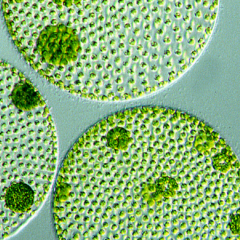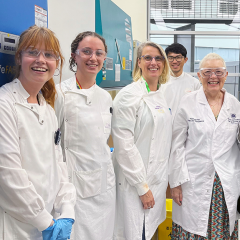Next time you receive a package at your house, take a moment to appreciate that the same process is occurring at a microscopic level within your own body.
Just as your cargo is packaged up safely and put on a vehicle to be delivered to your doorstep, so your body has molecular machines responsible for packaging cellular cargo and ensuring it is transported to the correct location.
And, just as this process can go awry in your neighbourhood, so it can in your body.
While having your package languishing in a warehouse or delivered to your neighbour’s doorstep instead of your own is frustrating, the consequences of misdelivered cargo in the body can be far more serious, leading to devastating neurodegenerative diseases such as late-onset Parkinson’s.
An international team led by Associate Professor Brett Collins from the Institute for Molecular Bioscience and Dr John Briggs at the Medical Research Council Laboratory for Molecular Biology (UK) has taken a massive step forward in understanding cellular sorting and delivery.
Oleksiy Kovtun in Dr Briggs’ group, and Natalya Leneva, working between A/Prof Collins’ group and the group of Professor David Owen from the Cambridge Institute for Medical Research, joined with collaborators at the the Max Planck Institute of Biochemistry to solve the structure of retromer, the molecular machine responsible for ensuring the safe and efficient transport of cellular cargo.
Video: Structure of the membrane-assembled retromer coat by cry-electron tomography. By Oleksiy Kovtun & John Briggs.
This discovery was published in Nature, one of the world’s leading scientific journals.
Retromer is a protein complex found in a diverse range of species, from baker’s yeast to humans. A/Prof Collins has been studying it for more than a decade, slowly unravelling the mystery of how this protein structure influences the health of our whole body.
“Retromer controls a process called ‘membrane trafficking’. Essentially, it’s like a postal worker based at a cellular compartment called the endosome, the central sorting station of the cell. Different cargos are brought to the endosome from the cell surface and many other internal compartments, where they are then sorted to other destinations.”
After careful reconstitution, the team used cutting-edge technology called cryo-electron microscopy, which uses frozen samples to examine the intricate details of cellular structures at resolutions never before possible. The team were able to determine the three-dimensional structure of the entire yeast retromer complex in its fully assembled, membrane-bound state.
“This exciting structure reveals an array of molecular arches and curving membranes, showing us how this protein machinery is assembled and providing important insights into how it works,” A/Prof Collins said.
“Whether in yeast or humans, retromer’s job is to keep our cellular machinery functioning at an even level, through regulating the levels of proteins in our cells.
“But retromer is also implicated in various diseases in humans. It can be hijacked by viral and bacterial pathogens for example; but most prominently its mutation is known to lead to Parkinson’s disease. We hope our work will allow scientists to better understand how mutations in retromer lead to neurodegeneration. In the very long term, this discovery could provide a basis for designing drugs to help target the retromer complex and treat disease.”
So, next time you’re waiting for a package to arrive at your door, take a moment to appreciate not only the amazing machinery doing the same thing in your cells, but also the work of researchers around the world who are helping us appreciate and understand these complex structures.
The research was supported by organisations including the National Health and Medical Research Council of Australia and the Australian Research Council.



